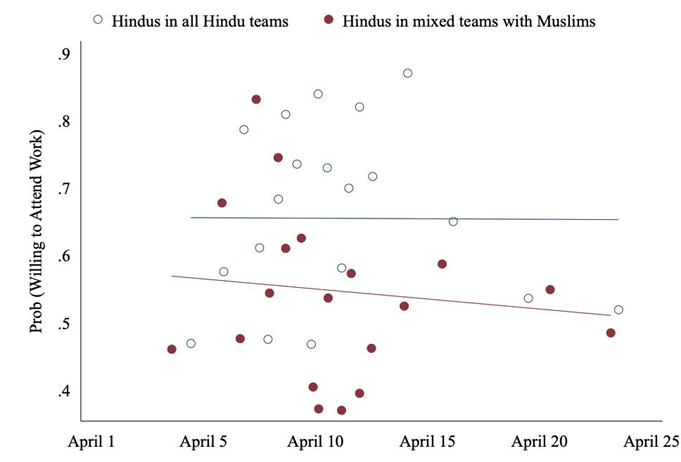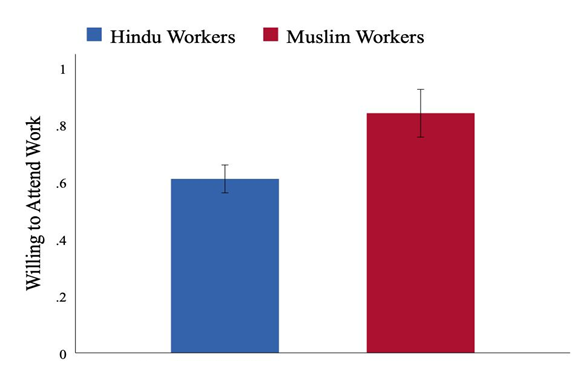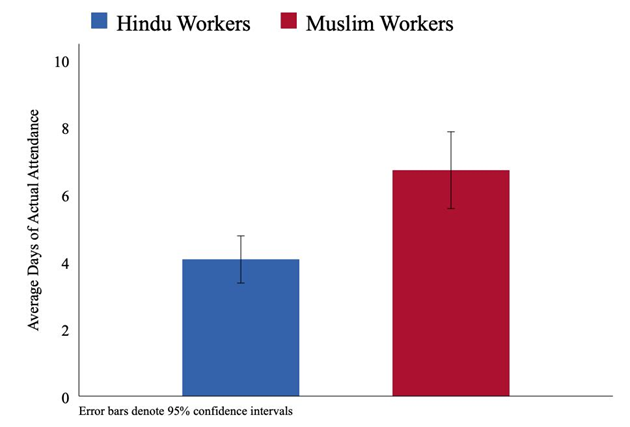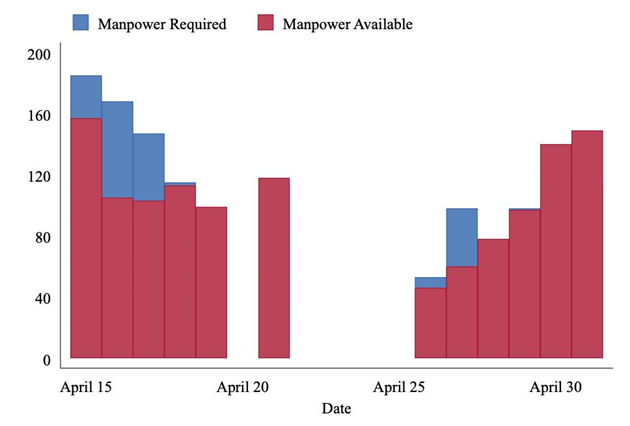Since the Tablighi Jamaat event – an Islamic congregation held in Delhi in mid-March – led to a large cluster of Covid cases, malicious rumours about Muslims spreading the disease started circulating in India. Based on a phone survey of 500 workers of a factory, this note shows that such rumour-spreading has negative labour supply effects amongst Hindus who have Muslim co-workers.
Early in 2020, as countries around the world were beginning to worry about the novel coronavirus, India was gripped by demonstrations about the controversial Citizenship Amendment Act (CAA). This eventually led to Hindu-Muslim riots in New Delhi, late in February. Meanwhile, as Covid cases kept rising in India, experts pointed out that India’s fight against the pandemic would involve multiple challenges – with some of the most densely populated areas in the world and an economy of 1.3 billion people already sliding towards recession, India’s fight on the economic front would be as difficult as it would be in stopping the spread of the virus. However, rather than uniting the country with a common cause, few of us would have expected the crisis to be also communalised on religious lines.
The Tablighi Jamaat event - a large Islamic congregation held in New Delhi in mid-March turned out to be one of the largest hotspots of the infection, with travellers from the event possibly infecting many others around the country. Since then, malicious rumours about Muslims spreading the disease started circulating on social media. This has led to discrimination against Muslims vendors and hawkers, who were attacked in many parts of the country. In this note, I show that such rumour-spreading has negative labour supply effects amongst Hindus who have Muslim co-workers. This could have economic consequences as India exits the lockdown.
In April, I conducted a phone survey with 500 workers at a factory in India – I have been working with this plant over the last year on a project that studies how inter-group (religious) contact at the workplace affects teamwork and productivity. The factory was shut when the lockdown was imposed on 24 March and began operating again in mid-April. Throughout this period, I interviewed workers at the plant and asked them if they are willing to join work immediately if the factory asked them to (production at the factory is considered essential service and is allowed by the government to operate). The factory has arranged permission from local authorities for its workers to be allowed to come to work.
Figure 1. Proportion of workers willing to attend work (by religion)
Figure 1 presents summary statistics of workers’ response to this question. Overall, roughly 67% of the workers report that they would be willing to re-join work. There is, however, stark contrast between the responses of Hindu and Muslim workers. Eighty four percent of Muslim workers report to be willing to return to work whereas only 61% of Hindu workers do so.
The workers generally report social stigma associated with leaving the locality and actual inability to leave their house (if they are in a containment zone, which is the case only for very few workers, and unlikely to explain data patterns that follow) as reasons why they cannot re-join. Hindu workers tend to additionally report they are worried about Muslims carrying (and spreading) the coronavirus as one of the reasons for not willing to come to work.
To study this more systematically, I split Hindu workers at the factory into two groups:
- Those that are in teams with only Hindu co-workers
- Those in mixed teams with both Hindu and Muslim co-workers.
In Figure 2 below, I present a plot of daily responses of the interviewed workers – separately for these two groups of Hindu workers – regarding their willingness to attend work.
Figure 2. Willingness to attend work (Hindu workers by team type)

Note: Factors such as workers’ age, tenure, area of work, and type of employment contract with the firm (permanent or contractual) have been accounted for.
It can be seen that Hindus in teams with Muslims are significantly less willing to attend work, compared to Hindu workers in religiously homogeneous teams. I estimate this difference to be around 11.5 percentage points.2 Lower willingness to work amongst Hindus (relative to Muslims) in general can be explained by various factors including differences in knowledge about the disease, the perceived risk of exposure, concern about sharing common eating and washing areas with Muslim workers in the factory, etc. However, the difference in responses of Hindus across the two types of teams is likely driven by the expectation of greater proximity to Muslim co-workers in mixed teams.
The next important issue to consider is whether these changed perceptions amongst Hindu workers actually lead to manpower shortage at the firm, which could in turn result in lost output. To do this, I present attendance data from the factory for the month of April in Figure 3, split by worker religion. It is important to note three things before I do this:
- The factory is currently operating at reduced capacity, and therefore the number of workers required at this time is less than at it would be under normal circumstances. Only a certain fraction of workers are actually required to come to work, depending on which production line is operating (there are multiple lines).
- In the analysis that follows, I include every worker who was contacted to come to work, irrespective of whether they attended work at all or not. (So workers who were contacted but never attended work would be given a value of 0 days of attendance.)
- It was declared by the management at the firm that workers would be paid their entire salary throughout the months of March and April, irrespective of whether they came to work or not (though there would be added incentive for those who attend). Concern over non-payment of salary is therefore unlikely to determine attendance over this period.
Figure 3. Average days of actual attendance (by worker religion)
Figure 3 shows average attendance (out of a maximum of 12 days, until the end of April) of Hindu and Muslim workers separately. Hindu workers who were contacted attend, on average, a little over half as many days of work as their Muslim counterparts. This behaviour is consistent with the survey response summarised in Figure 1.
While there is little doubt that non-attendance of workers is leading to manpower shortage and therefore negatively affecting production, it is difficult at this time to quantify the amount of this loss, as several factors are changing simultaneously. The firm has adopted physical distancing policies that are likely to negatively affect output, as are worker team changes due to non-attendance. Nevertheless, in Figure 4, I present an event plot of daily available manpower against required manpower to provide a sense of the degree of manpower shortage.
Figure 4. Required versus available manpower
It can be observed from Figure 4, that the factory experienced large shortages (blue bars higher than red ones) in manpower initially as it re-opened during the lockdown. Shortages reduced over the next few days, but so did required manpower – perhaps because of lower product demand due to the lockdown or the factory revised its expectation of worker attendance downwards. However, as production expands, this might become a more serious problem if low attendance continues.
In order to understand whether Hindu workers are being rational in their behaviour, we would have to analyse data on coronavirus infections by demographic groups to see if Muslims are actually infected relatively higher than their share in the population. To the best of my knowledge such data are not yet available. However, it is safe to say malicious rumour spreading has increased discrimination, the effects of which are beginning to be felt in the private sector and could continue to cost Indian firms in the days to come, as India exits the lockdown. It is possible that more workers will start returning to work as firms go back to paying salary based on attendance, but increased discrimination at work could still have negative effects on productivity. The government needs to take active steps to fight these rumours – the economy is already suffering enough without this additional cost.
The author would like to thank Aaheli Chakraborty, Abhirup Majumder and Moiury Gope for assistance with data collection.
Notes:
- A 95% confidence interval is a way of expressing uncertainty about estimated effects. Specifically, it means that if you were to repeat the experiment over and over with new samples, 95% of the time the calculated confidence interval would contain the true effect.
- Based on a ‘pooled regression’ (across all survey days) of willingness to attend work on team type. The estimate is statistically significant at the 1% level.




 08 May, 2020
08 May, 2020 







By: Arkadev Ghosh 13 May, 2020
Hello A Chowdhury, Thanks for your comments. Your question about share of migrant workers is important. They comprise of only about 8% my sample - and this number does not vary significantly by religion. Therefore, it is unlikely to drive any of the data patterns.